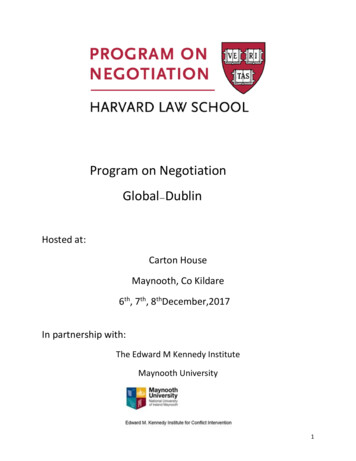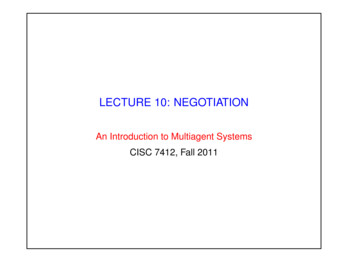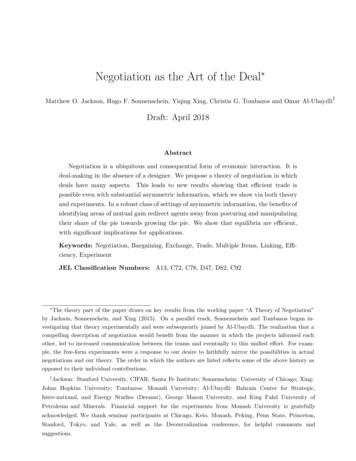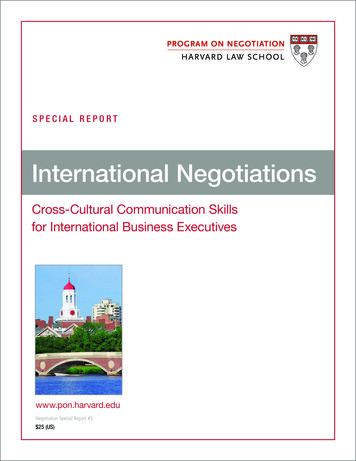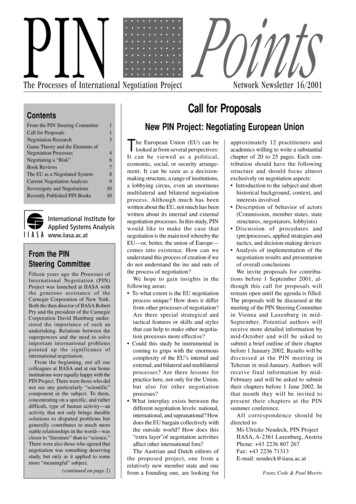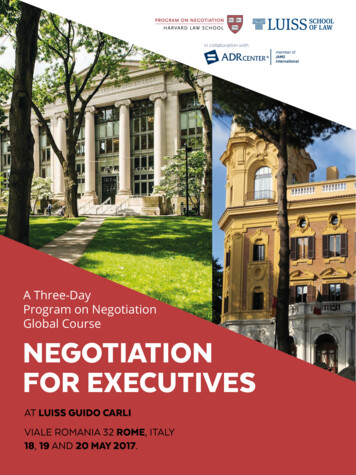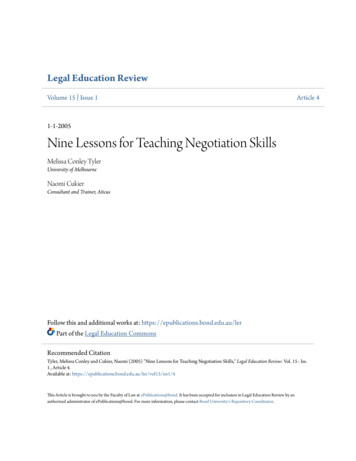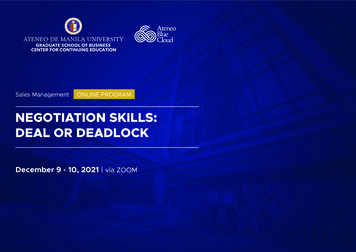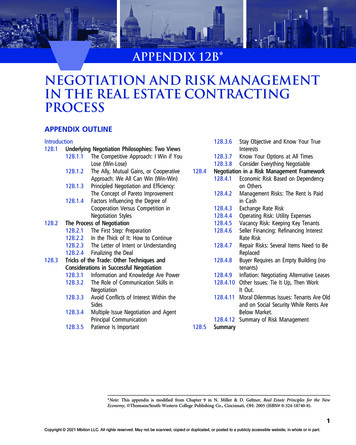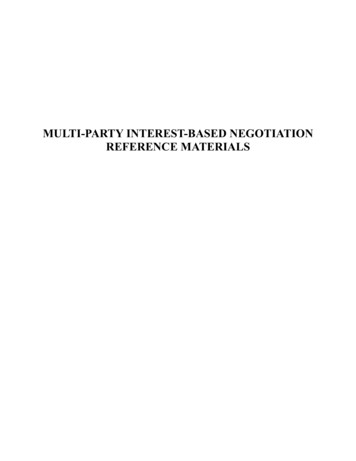
Transcription
MULTI-PARTY INTEREST-BASED NEGOTIATIONREFERENCE MATERIALS
Multi-Party Negotiation/Conflict Management Executive WorkshopMULTI-PARTY INTEREST-BASED (IBN) NEGOTIATION“The benefits of group decision-making have been widely publicized:better thinking, better “buy-in,” better decisions all around There isno substitute for the wisdom that results from a successful integrationof divergent points of view. Successful group decision-making requiresa group to take advantage of the full range of experience and skills thatreside in its membership.”Sam micsTraditional bargaining is often about relative power and willingness to use it against each other,often at the expense of a better agreement or relationship; however interest-based negotiation(IBN) has proven its effectiveness in multi-party settings.U.S. Institute for Environmental Conflict ResolutionR-1
Multi-Party Negotiation/Conflict Management Executive WorkshopI. IBN BASICSIBN is based on a simple premise: negotiation takes place between people. It uses a cooperativeapproach and postulates the idea that all parties must come away having gained something. Theprocess of interest-based negotiation: Enables negotiators and leaders to become joint problem-solvers by offering anopportunity to address the collision of conflicting interests in a proactive manner that canlead to better outcomes for all parties involved. Provides a way to address the challenge of multiple interests and the need to developbroader, more creative options to address a multiplicity of needs and mandates within thesame negotiation context. Assumes that mutual gains are possible, that costs or sacrifices can be minimized orshared, that solutions that satisfy mutual interests are more durable, and that parties canhelp each other achieve better outcomes for all than are currently available. Assumes that value is added and efficiencies can be realized through this analyticprocess. Assumes that solutions designed together will endure.Core Principles of Interest-Based Negotiation Prepare carefully to negotiate and understand your BATNA (Best Alternative toa Negotiated Agreement). Seek to separate the people from the problem and focus on future outcomes andnot the past. Create value by making the “pie” larger by: Focusing the negotiation on interests and not positions (which are generallymore rigid and do not offer the opportunity for creative thinking). Jointly generating options creatively, waiting to analyze each until after theoption development process is complete. Establishing joint criteria together and using them to evaluate the optionsgenerated. Creating jointly agreed standards for how to divide the “pie.” Jointly establishing the necessary post-agreement activities, building inflexibility for changing circumstances and how to deal with disputes thatmay arise during implementation.U.S. Institute for Environmental Conflict ResolutionR-2
Multi-Party Negotiation/Conflict Management Executive WorkshopII. MULTI-PARTY NEGOTIATIONMulti-party negotiation is a complex, iterative process involving the exchange of views, ideasand perspectives among a number of parties that might include organizations, groups, regions,countries or individuals within larger entities. Complexity may appear chaotic, especially in theabsence of structure and leadership. Note: Agency parties may be concerned they are abrogating their legal responsibility in negotiation. Agenciescannot legally give up their jurisdiction. Collaboratively developed policy agreements are typicallyrecommendations to the governing bodies. However, our experience since the mid-1970’s in theenvironmental arena has shown that the consensual approach can fit within the constraints imposed by thelaws and regulations which are explicit “sideboards” of negotiation as long as the negotiation process isconducted openly and all interested parties are invited to participate, are committed to participate, and canengage effectively. If the product of the negotiation is an informal written document that must be adoptedformally, all due process and equal protection requirements can be met.A. Key Similarities To Two-Party Negotiation Parties are generally trying to reach an agreement that leaves them better off. Basic Principles of Interest-based Negotiation still apply: Uncovering values.Identifying and clarifying interests.Seeking to create as much value as possible.Encouraging joint problem solving.B. Key Distinguishing Features From Two-Party Negotiation Parties may attempt to form coalitions for advantageous deals and block other coalitionsin order to protect interests or gains that may be threatened. Group interactions and communication patterns become more complex. Decision rules take on increasing importance as multiple decision rules come into play(agreements, disagreements, side agreements). More is done “away from the table.” More external factors come into play, including political influences/interactions. Possibility for role confusion (am I the leader?, agent?, facilitator?, etc.). The more parties at the table, with more to trade, the greater the possibility for trade-offs.U.S. Institute for Environmental Conflict ResolutionR-3
Multi-Party Negotiation/Conflict Management Executive Workshop A larger group may bring more expertise and creativity. Negotiating with one’s constituencies often runs parallel to inter-party negotiations.III. COMPLEXITYMulti-party negotiation is not merely two-party negotiation with “more people.” Multi-partydynamics generate complexity across all of the dimensions of the Frames of Reference triangle:group dynamics increase exponentially because of the multiplicity of people, interests, anddiffering Best Alternatives to a Negotiated Agreement (BATNAs); relational dynamics becomemore complex, such as role definition and issues of unequal power and control; and substantiveissues also increase in complexity, such as increased potential for misinformation, differingviewpoints and interpretation of data and different views on the mission and mandates of thegroup.A. Complex CommunicationCommunication is an overarching skill that applies to negotiation in general; however, multiparty negotiation and complex conflict management require the application of the samecommunication skills with an added level of attention and awareness of the increased dynamiccomplexity of a multi-party setting. In multi-party situations, the skills of listening, attendingand questioning are required in multiple dimensions, analogous to an imaginary shift from agame of chess between two people to a game of chess in three-dimensions against multipleopponents.B. Relational ComplexityThe presence of additional parties to the negotiation or conflict management situation alsogenerates an increase in relational complexity across the following areas: Individual and organizational values Issues of trust and credibility (of individuals and organizations) Issues of face at the table and within represented organizations/constituencies Issues of identity and roles at the table and within representedorganizations/constituencies1. Multiple Bargaining RelationshipsMultiple bargaining relationships are part of the complex and shifting dynamics in multiparty negotiation and conflict management settings and exist in several forms:Coalitions. In multi-party negotiation, the opportunity exists for coalition-forming behavior,whereby parties will seek to create coalitions and alliances with other parties.U.S. Institute for Environmental Conflict ResolutionR-4
Multi-Party Negotiation/Conflict Management Executive WorkshopHorizontal (within-group). Negotiations necessary to achieve a smoothly functioning group.This type of negotiation allows members to: Bargain on items of personal concernArrive at a group definition of the problems to be handled in joint sessionDevelop settlement options that have broad group acceptanceDevelop individual and group strategiesAssign roles and responsibilitiesVertical. Where parties do not have absolute authority to make a final decision on an issue inquestion. There are two forms: Bureaucratic – where approval must be gained from or delegated by parties higherin an organization.Constituent bargaining – when broader groups must approve the agreement.Bi-lateral/Multi-lateral. Formal discussions between teams or spokespersons across thetable, often used to educate each other about the issues, put forth proposals, and ratify finaldecisions.Strategies for Managing Relational Complexity Focus on relationship-building. Find common interests that will motivate the group to work together more effectively. Focus on building and maintaining trust. Acknowledge and respect diversity of styles without letting the differences derail theagreement process. Be aware of and understand coalition forming behavior: which coalitions will likely form;winning and blocking coalitions; what are the decision-making rules. Understand how facilitative leadership can enhance good relationships with parties. Understand commitments and changing contexts that affect negotiating parties. Use caucusing, both formal and informal, as a way to improve group dynamics, reducedisagreements on substantive items, educate each other about the issues, and move thenegotiation forward.U.S. Institute for Environmental Conflict ResolutionR-5
Multi-Party Negotiation/Conflict Management Executive WorkshopC. Unproductive Group Dynamics1. Group-thinkWhen a set of individuals acts and thinks as one and often to the detriment of individualmembers’ experience, knowledge, and wisdom.2. Under the TableWhere parties negotiate with other parties “under the table” outside of the larger group to thedisadvantage of the greater group process, where information is not shared with the largergroup and can create mistrust and second guessing of colleagues. This situation goes againstthe basic principles of agency engagement discussed in the Appendix.Strategies For Managing Unproductive Group Dynamics Determine that everyone still understands, agrees on, and buys into themandate and the mission. Reaffirm or establish a plan for formal arrangement/cooperation/coordination (interagency, military, civilians, etc.). Establish clear lines of communication. Establish clear lines of responsibility. Establish jointly agreed-upon decision-making rules. Jointly establish clear roles and organizational structures. Generate flexible contingency planning together. Develop agreed-upon plan for implementation and follow-up. Understand that stress can lead to less efficient information processing, lessability to deal with subtleties and more reliance on ingrained habits andbiases.U.S. Institute for Environmental Conflict ResolutionR-6
Multi-Party Negotiation/Conflict Management Executive WorkshopIn addition to IBN QuestionsAdditional Key Questions To Ask When Assessing the Dynamics*Preparation What pre-assessment has been done before getting together?What are the existing relationships between the parties?What is the history of the issues?What is the collaboration history and style of the parties and the organizations theyrepresent.What are the represented organizations’ approaches to negotiation.What issues are likely to be raised within the process?Representation Who are the parties, the representatives (advocates), and the decision-makers?Can the right people be brought to the table?What is the best way to convene the parties?Mandates and Influences What are the institutional constraints of each party?Do the parties have the authority to negotiate and make decisions?What are the political constraints of each party?What are the general and specific mandates of participating agencies and others and howmight they conflict?Resources How will the negotiation be financed?Who is the lead on financing, developing the budget?What time and personnel investments are required?Management Who will manage the process?How will communication be managed?How will the group make decisions?How will coalition dynamics be managed?* These questions should also be revisited when the group comes together.U.S. Institute for Environmental Conflict ResolutionR-7
Multi-Party Negotiation/Conflict Management Executive WorkshopKey Structural Strategies for Managing ComplexityPhase I: Preparation/Planning Identify the problem/situation.Establish group operating rules.Clarify legal basis for activities.Identify potential obstacles and determine how they can be avoided or prevented.Set timelines agreed to by all the parties.Determine funding sources, constraints and other resource availability.Avoid designing overly prescriptive rules and group policies.Determine decision-making process where final and shared authorities are clarified.Phase II: Negotiation Process Establish group goals and objectives.Agree on a joint definition of the problem/situation.Jointly agree on data to be used and what resources need to be brought to the table.Establish the objective criteria to be used for evaluating options.Jointly design the process road map.Establish implementation responsibilities.Phase III: Developing Agreements Evaluate options in light of criteria and resource availability.Develop a framework outlining in general terms how the problem should be resolved(agreements in principle).Negotiate and reach closure on each issue separately (“building blocks” approach).Blend comprehensive proposals developed by the parties into a final agreement (blendingproposals).Acknowledge disagreements, agree to disagree civilly, yet focus on solutions designedtogether.Phase IV: Post-Agreement Determine implementation responsibilities.Acknowledge collaboration of multi-party negotiation team and the mutual benefitsdesigned together.Implement agreed upon actions/decisions.Develop procedures for monitoring and evaluating implementation of actions/decisions.Clarify circumstances that would warrant revisiting the agreement.U.S. Institute for Environmental Conflict ResolutionR-8
Multi-Party Negotiation/Conflict Management Executive WorkshopFACILITATIVE LEADERSHIP“Effective leaders present the world with images that grab ourattention and interest. They use language in ways that allowus to see leadership not only as big decisions but as a series ofmoments in which images build upon each other to help usconstruct a reality to which we must then respond.”Fairhurst & Sarr, 1996Facilitative Leadership Competencies Organizational Skill – ability to organize steps, people and information,including planning. Responsiveness – appreciation for parties’ needs, opinions, and directions, andreal-time responsiveness. Content Insight – ability to understand the content and follow the meaning ofdiscussions. Communication Skill – adept at both speaking and listening effectively. Flexibility – ability to change as the situation changes and to deviate fromone’s plans as the group dynamic evolves. Ability to respond to unexpectedcircumstances. Adaptability – ability to adapt language, technique and style to the parties’needs. Human Insight – ability to read others, understand their needs, concerns,attitudes and fears. Nonverbal Sensitivity – ability to read nonverbal cues and understand howparties are responding and feeling about a topic just by reading their face,gestures and postures. Depth of Technique – ability to respond to any situation with processes,interventions and techniques to facilitate the group’s work and developmentprogress. Inventiveness – ability to invent new processes or alternatives in real time tofit the situation. Timing – ability to know when to and when not to intervene in a process,when to transition to another issue, and when to bring a process to closure.U.S. Institute for Environmental Conflict ResolutionR-9
Multi-Party Negotiation/Conflict Management Executive WorkshopA. FACILITATIVE LEADERSHIP ResponsibilityHighFrom Terry R. Bacon, 1996Facilitation of group interaction requires skillful interaction and an understanding of thedynamics of group interaction, communication and development. An effective facilitative leaderis able to observe and participate in a group process, to contribute to the negotiation processwhile simultaneously influencing the way in which the group members work together. Importantroles for an effective facilitative leader include: Modeling principles and practices of respectful engagement and communicationInitiating discussionEncouraging and balancing participationManaging conflictsPacing the work of the groupSuggesting process strategiesHelping parties communicate and collaborateEstablishing the benefits of collaborationU.S. Institute for Environmental Conflict ResolutionR-10
Multi-Party Negotiation/Conflict Management Executive WorkshopB. MINDSETOne’s mindset is one of the most critical factors determining the success of a relationship andunderlies how you communicate and how others respond to you. One’s mindset also determinesthe positions you hold, which in turn influence the way you conceptualize a problem and how toapproach its resolution. Parties can gain a better understanding of a conflict situation byunderstanding not only their own mindset but also the variety of specialized perspectives at thetable. Fisher et al (1994) describe an Atlas of Approaches of points of view to better understanda conflict. He describes a case of fragmentation in Russia through several perspectives:Atlas of ApproachesCase: Fragmentation in Russia, 1993As a military officer might see it:What’s the problem?Military leadership at odds with political leadershipOther republics represent potential threats and drains on resourcesChanges in geopolitical situation diminish need for militaryWhat might be done?More effective liaison between political factions and militaryCreate mutual nonaggression pactsRetrain military personnel for internal security measures, such as attackingorganized crimeAs a political analyst might see it:What’s the problem?Fragmented leadershipRising regionalismCommunist party decline created power vacuumWhat might be done?Integrated, unified leadershipEstablish confederation supporting explicit mutual assistanceDemocratically elected governmentAs a communication expert might see it:What’s the problem?Local media coverage of events is ineffective; people don’t know what’shappeningNews is inaccurate and disseminated slowlyCountry lacks widespread modern communication technologyWhat might be done?Import some BBC expertsReuters or AP expands offices in area, hires locals, trains themFull privatization of mediaJoint business ventures between Russian media consortium and Westerntechnology groups(From Fisher et al, 1994)U.S. Institute for Environmental Conflict ResolutionR-11
Multi-Party Negotiation/Conflict Management Executive WorkshopCONFLICT MANAGEMENT“Managed well, “conflict” can power great change andcreativity. Poorly managed conflict can generate disputes thatconsume massive quantities of time and money, destroyvaluable relationships and sabotage important projects ”McNaughton, 2002ConflictCausesPerceptionsResponsesConflict is the expression of the interaction of different interests. It is dynamic. It can be thespark which sets the negotiation process in motion, or it can arise as negotiation takes place. It isuseful as a catalyst to action when appropriately addressed. When conflict involves multipleparticipants, beyond one-on-one disputes, the complexity and multidimensional nature of theproblem is increased dramatically. Unmanaged conflict can escalate in intensity over time: sidesform, positions harden, and communication stops; perceptions become distorted and a sense ofcrisis emerges whose outcomes may range from avoidance to annihilation.U.S. Institute for Environmental Conflict ResolutionR-12
Multi-Party Negotiation/Conflict Management Executive WorkshopRESPONSES TO CONFLICTBasic perceptions of conflict affect choices for negotiation and managing complex settings.People respond differently when confronted with conflict; for example, consider the behaviorsthat result from different perceptions of conflict:Perception of Conflict as Negativecan lead to:Perception of Conflict as Positivecan lead to: Competing Cooperating Compelling through authority Leading by example or throughfacilitation Denying/Capitulating Problem solving Power bargaining Engaging constructively Engaging prematurely Building consensus Neglecting long term or unintended consequences Committing to long term resolution Destroying relationships and networks necessaryfor functioning effectively Engaging in relationships for the longtermThe Thomas-Kilman Conflict Instrument describes five styles of response to conflict: Avoiding,Accommodating, Competing, Compromising and Collaborating. This baseline for selfunderstanding is an essential and critical first step toward understanding the variety of styles andapproaches in any multi-party negotiation. High concern for the outcome and the importance ofthe relationship increases the desire for or likelihood of collaboration; whereas low concern forthe outcome and low importance placed on the relationship results in a greater tendency to avoidconflict. Becoming skillful at managing conflict starts with understanding one’s own tendencieswhen faced with conflict and then examining the advantages and disadvantages of each ratingCompromisingAvoidingCompetingConcern for OutcomeFrom Thomas-KilmanU.S. Institute for Environmental Conflict ResolutionR-13
Multi-Party Negotiation/Conflict Management Executive WorkshopKey Points for Managing ConflictHow conflict is managed can lead to the creation (or not) and maintenance of relationships thatprovide for better coordination and responsiveness. Effective conflict management involves thefollowing steps:1.Describe what you see through factual observation (avoid making assumptions).2.Explore and consider the universe of interpretations to the event/behavior (what don’t Iknow).3.Assess the dimensions of the conflict, participants and process.4.Analyze the causes of the conflict in light of the Frames of Reference: Psychological IssuesSubstantive IssuesProcedural Issues5.Evaluate your analysis and identify the positive and negative reactions to theevent/behavior.6.Allow each party to voice their perspective and experience, which validates each party’sworth and right to be part of the discussion.7.Reframe a fuller definition of the problem based on an understanding of multipleperspectives.8.Develop a constructive strategy for dealing with the conflict by: 9.Building constructive working relationshipsDeveloping a collaborative planning processDevelop a range of alternative approaches or solutions and collectively test them forviability.10. Achieve lasting solutions that take into account interests, not positions, and address alldimensions of the Frames of Reference triangle.U.S. Institute for Environmental Conflict ResolutionR-14
Multi-Party Negotiation/Conflict Management Executive WorkshopBUILDING RELATIONSHIPS“ A critical element in any negotiation – and one thatfrequently causes the most anxiety – is the quality of theworking relationship we have with the other side The qualityof a relationship is not just something that happens. It is theproduct of how we deal with each other.”Roger Fisher and Danny Ertel, y negotiation and conflict management requires the ability to enter into, build, andfoster relationships among the parties in the negotiation or dispute, a process which takes time tocultivate and maintain. Building relationships is essential to building trust. Trust is essential tosuccessful group efforts and underlies effective joint implementation of agreements.Core relationship-building skills include: CommunicationCognizanceCollaborationI. COMMUNICATIONKey Check-In QuestionsIn order to communicate effectively, ask the following questions throughout theprocess: Is my communication getting me where I want to be? Am I communicating appropriately for the situation? Are my expectations and behaviors flexible enough to adapt tochanging circumstances/situations?U.S. Institute for Environmental Conflict ResolutionR-15
Multi-Party Negotiation/Conflict Management Executive WorkshopCommunication is inherently subjective, and should be conducted with the understanding that:1. On the “speaking” side, people vary in the strategic and tactical choices they make aboutwhat to communicate, the degree of clarity they wish to create, their body language, andtheir capacity to communicate in ways that can be understood.2. On the “listening” side, people vary in their willingness to listen, their capacity to beattentive, their expectations and biases, their ability to understand the other’s meaning,their emotional response to that meaning, their own internal needs to rebut/giveadvice/appraise/impress the other, and their susceptibility to physical barriers.Multi-party negotiations can be managed effectively and constructively when there is adisciplined focus of all parties on fundamental communication principles.A. Fundamentals Of Basic CommunicationIn order to communicate so that others “hear” you, remember the following: By nature, all human beings are self-absorbed. Their attention is selective, and they hearbest about what affects them most. Human beings process information through such filters as emotions, values, needs,interests, and biases (cultural and otherwise). Words and their meanings are a small part of any message. Much of the message in aface-to-face conversation is conveyed nonverbally. When communication occurs overthe phone, the nonverbal nuances are missing. Miscommunications can occur. Trust issometimes harder to build.B. Active Skills For Effective Communication1. Listening ReflectivelyListening reflectively involves creating strategies for helping yourself listen more effectively,testing whether you are hearing what the other is trying to communicate, and drawing the otherout to speak at more depth and with more meaning, so that you can understand their concernsand interests more clearly.2. QuestioningEffective questioning enhances your ability to learn, listen, and facilitate better communication.Open-ended, follow-up and closed questions can be used to focus a discussion, to clarify orprobe, to encourage participation, to facilitate discussion, to build a relationship, and to stimulatecreativity.U.S. Institute for Environmental Conflict ResolutionR-16
Multi-Party Negotiation/Conflict Management Executive Workshop3. Handling and Understanding Responses to QuestionsHandling how you respond to questions is important when trying to create effectivecommunication. Some simple rules include: listen carefully; summarize or reframe the responseif it is long or complex, or just to assure that you got it right; and use follow-up questions asappropriate.4. FramingFraming or reframing can be used to define or re-define a specific issue or group of issues in aconflict or the conceptualization of a situation or conflict to: Assure that the statement made by the speaker is clearly understood. Capture the underlying interests and concerns of the speaker. Help take apart complex issues in order to analyze them together more effectively. Help discern and build upon partial agreements and shared logic between parties. Help shift the discussion from rigid positions to a focus on interests and needs.Framing a negotiation issue properly (using all parties to develop it) can make the difference inwhether or not people successfully negotiate in any negotiation setting.C. Balancing Listening and AssertingAsserting appropriately is a critical component of being a good negotiator. Asserting, balancedwith listening, produces more effective negotiation communication. Asserting consists of fivebasic skills listed below.BALANCING COMMUNICATIONASSERTINGU.S. Institute for Environmental Conflict ResolutionLISTENINGR-17
Multi-Party Negotiation/Conflict Management Executive WorkshopClarifying intentions Be clear about goals and needsRemaining Centered Be poised – neither defensive nor aggressiveRemain emotionally balancedExpressing State your position clearlyAvoid vague words or qualifiersUse a confident tone of voiceSupporting Use strong, definitive gesturesUse appropriate eye contactMaintain steady, assured posturePersisting Have the courage to persevereBe resolved but open to collaborationU.S. Institute for Environmental Conflict ResolutionR-18
Multi-Party Negotiation/Conflict Management Executive WorkshopDegrees of AssertivenessDo it or else.Do it now.Do it.Please do it.I want/would like you to do it.I need you to do it.I would appreciate it if you woulddo it.If I’m not imposing, I’d like you todo it.Would you do it?Would you please do it?Would you like to do it?Would you mind doing it?Do you have time to do it?Could I ask you to do it?Shall I do it myself?Okay, I’ll do it.U.S. Institute for Environmental Conflict ResolutionR-19
Multi-Party Negotiation/Conflict Management Executive WorkshopD. Challenging BehaviorConflicts that originate from differences in personal or organizational operating style are besthandled through exploring differences, listening, and then acknowledging. However, difficultymay arise where parties exhibit more challenging types of behavior. Building on successfulinterventions that address difficult behaviors will encourage multi-party negotiation.1. AngerAnger is a legitimate human emotion. Anger within the negotiation context most often arisesover violations of trust, differences in value, expressions of stubbor
Multi-Party Negotiation/Conflict Management Executive Workshop U.S. Institute for Environmental Conflict Resolution R-3 II. MULTI-PARTY NEGOTIATION Multi-party negotiation is a complex, iterative process involving the exchange of views, ideas and perspectives among a number of parties that might include organizations, groups, regions,
